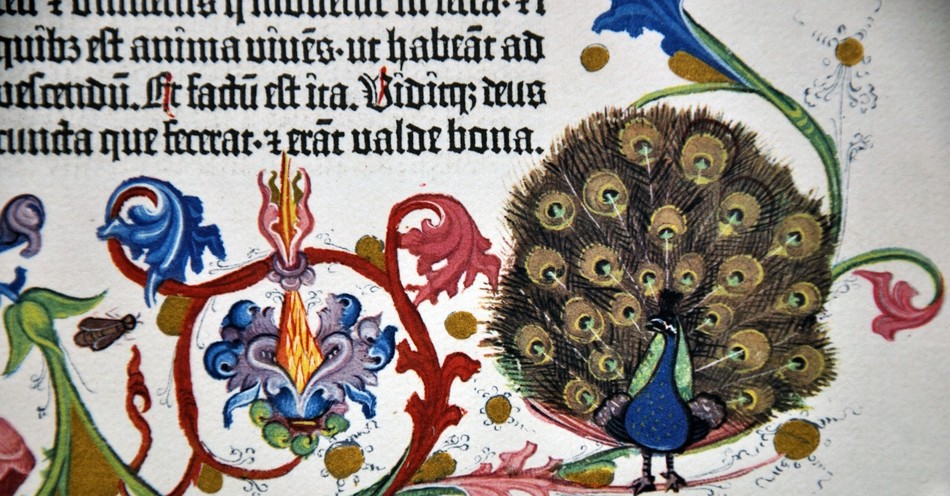One of the rarest, and undoubtedly, distinguished books of history, the Gutenberg Bible was among one of the first printed books of history, the very first in the west. Likely one of the most famous Bibles in the world, this served as a forerunner to books printed via “moveable type.”
In other words, prior to 1455, the date in which the Gutenberg Bible was printed, writers would copy the Bible by hand. By using an innovative printing process at the time, Gutenberg allowed for the Bible to be copied at a much faster rate than it had ever been previously.
Known as the Forty-Two Line Bible, each of the two columns featured in this Bible have 42 lines each on all the pages.
In this article, we’ll dive into the history of the Gutenberg Bible, its importance in church history, and why this matters for us today.
A Brief History of the Gutenberg Bible
Born to a wealthy family at the tail end of the 14th century in Mainz, Germany, Johann Gutenberg had grown accustomed to reading books growing up that had been copied by hand. During his formative years, he watched as a faster process, known as block-printing, come about.
If you know what a stamp looks like, how the reverse image stamps ink onto a page as a mirror image, you would be familiar with how the process of block printing worked.
Nevertheless, even though block printing cut down on the time of transcribing each page of the Bible by hand, the process didn’t come without its quirks. Printers had to individually cut out each word on a block of wood used for one page of the manuscript and had to repeat the process for every other page.
After a great deal of trial and error, and a lawsuit, Gutenberg sped up the process of printing by creating a moveable machine that printed the work much faster than his predecessors.
Although he gained virtually no profit from this machine, he did lay the groundwork for mass-produced books. Not only does his invention have great importance in the history of literature, allowing more books to enter the hands of more readers, but also in the history of Bibles.
We do have to keep in mind that he printed the work in Latin. Bibles didn’t receive an English translation until 1525, with the Tyndale Bible.
Gutenberg probably didn’t have the layperson in mind when he printed this Bible, but he did bring us one step closer to allowing all readers to have a copy of their own.
The Importance of the Gutenberg Bible in Church History
As mentioned before, this introduced printed books in the West. But this also allowed Christians to fulfill the Great Commission by spreading the gospel unto the ends of the earth (Matthew 28:16-20).
Readers may wonder, What’s the big deal? He created a machine that could print work a little faster than the block printers. So what?
We have to understand just how radical this machine was. It laid the groundwork for future printing presses and mass-produced books. Not only did Gutenberg find a way to make a more text-friendly printer (most of the “printers” of the day worked better with images than words), but he developed a new kind of metal alloy that helped stick the ink to the vellum pages better.
Not only does this invention exemplify God’s plan and gifts that he has given to believing inventors, but it shows God’s heart to reach everyone with his word.
Declare his glory among the nations, his marvelous deeds among all peoples (Psalm 96:3).
How Many Gutenberg Bibles Are Left?
Even though the Gutenberg Bible allowed for far more of the laity to read the Scripture, how many copies do we still have in existence? They had originally printed 180 copies, but we still have access to 49 today.
Although this may seem like a small percentage, we must bear in mind that copies can get lost over time. The fact we still have well over one-quarter of the originals, centuries later, serves as a testament to the preservation process.
If you want to snag your hands on one of these copies, you better come with some heavy cash flow. Gutenberg Bibles are now worth $35 million. Seems somewhat ironic considering the purpose behind this Bible was to ensure as many people, who could not afford expensive items, could have a chance to read Scripture.
However, if you want to simply look at the book to see a preserved piece of history, you can find the numerous copies in various locations. You can find the Gutenberg Bible at the New York Public Library, the Library of Congress, The Morgan Library & Museum, Harvard University, and various other locations.
The Importance of the Gutenberg Bible Now
The Bible today is the best-selling, and most widely distributed book in the entire world, in the entire history of the world. Between 1815 to 1975, the Bible saw a printing of 2.5 billion copies, it is likely closer to 5 billion now.
God calls us to spread his good news, and the best way to do so is by translating the Bible into every known language and making it available to all nations.
Gutenberg laid the foundation for the possibility of this.
One forerunner of what we know as the printing press allowed for 40-180 Bibles to be printed at one time. Gutenberg likely would’ve had more printings if he hadn’t run low on funds.
It matters that we know the history of the Bible (including the history of the mass-production of it) because we can see God’s fingerprints throughout history, even after the New Testament.
He has found ways to make his word available to so many nations, and Bible translators hope to have the Good Book translated in almost 7,000 languages worldwide by 2025.
Little by little, each invention, each translation, helps us to fulfill the Great Commission Jesus set before us, yes, even a little machine built in 1455.
Then the eleven disciples went to Galilee, to the mountain where Jesus had told them to go. When they saw him, they worshiped him; but some doubted. Then Jesus came to them and said, “All authority in heaven and on earth has been given to me. Therefore go and make disciples of all nations, baptizing them in the name of the Father and of the Son and of the Holy Spirit, and teaching them to obey everything I have commanded you. And surely I am with you always, to the very end of the age” (Matthew 28:16-20).
When we think about the Gutenberg Bible, we should remember the Ethiopian eunuch who spoke with Philip in Acts 8:26-40. He did not understand the words of Scripture until someone explained it to him. In the same way, we cannot expect people to know about the Bible unless we translate it or explain it. The Gutenberg Bible sought to do so and made the Gospel more accessible to a world in need who needed to hear it.
Photo Credit: Detail of page from a facsimile of the 1455 Gutenberg Bible, the first printed version of the Latin Vulgate. ©iStock/Getty Images Plus/Lakeview_Images
Hope Bolinger is an acquisitions editor at End Game Press, book editor for hire, and the author of almost 30 books. More than 1500 of her works have been featured in various publications. Check out her books at hopebolinger.com for clean books in most genres, great for adults and kids. Check out her editing profile at Reedsy.com to find out about hiring her for your next book project.




.jpg)